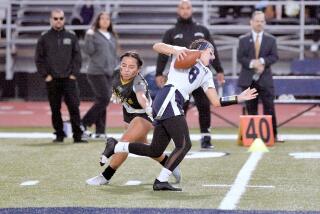There’s not much to see in La...
There’s not much to see in La Puente. Not yet, anyway.
The little sliver of a San Gabriel Valley city that once boasted huge walnut and citrus trees has become an urbanized suburb indistinguishable from its neighbor, the City of Industry. But a downtown revitalization project--along with a surge of young, college-educated families taking advantage of the city’s affordable housing--are giving the more optimistic residents hope for a mini-renaissance.
With most of its significant landmarks either destroyed in natural disasters or incorporated into the City of Industry, La Puente’s rich past is not well known. Earlier this month, when the city proudly celebrated the 40th anniversary of its incorporation, many of its residents were reminded of the little hints of history that still exist everywhere in the city.
La Puente High School’s mascot, the Indian, is an often unappreciated dedication to an entire Native American village that centuries ago roamed where the school now stands. By naming streets after early Spanish and English settlers, the present-day city also acknowledges what was once Rancho Puente, owned by William Workman and John Rowland.
The city seal--in which a bridge figures prominently--is another historical reminder: La Puente got its name from one bridge--and its independence from another.
In the 18th century, a pack of explorers passing through town built a bridge (or puente, in Spanish) to help their livestock cross the deep San Jose Creek. Some of those settlers stuck around, and Rancho Puente was born.
In 1956, a pickup truck’s rear wheel got caught in one of the area’s road bridges, leaving behind a gaping hole that Los Angeles County ignored for several traffic-treacherous weeks. Local anger against inefficient bureaucracy boiled. And an in corporation movement was born.
Because of border disputes with the City of Industry, not all of the area formerly known as Puente was included in the new city of La Puente. And landmarks such as the Workman House and an ancient Indian burial site were sliced out of the emerging city.
La Puente has had to say goodbye to much of its past, but in some cases the city has said good riddance.
As recently as 30 years ago, the region’s creeks would overflow in the winter and block traffic for hours.
Now, with most of the city’s waterways enclosed and channeled into the Los Angeles drainage system, La Puente’s roads are well-maintained.
And rather boring.
The bridges in La Puente, the city’s motif and namesake, have all but disappeared. There is still an asphalt bridge on Valley Boulevard, but locals say it’s not the same.
Still, La Puente knows a good theme when it sees one.
A 1981 city-issued newspaper celebrated La Puente’s urbanization, referring to the evolving community as a “bridge between the past and the future.”
(BEGIN TEXT OF INFOBOX / INFOGRAPHIC)
By the Numbers
CITY BUSINESS
Date incorporated: August 1, 1956
Area in square miles: 3
Number of parks: one
Number of city employees: 27
1995-96 operating budget: 11 million
****
ETHNIC MAKEUP
Latino: 75%
White: 15%
Asian: 7%
Black: 3%
Other: .5%
****
PEOPLE
Population: 36,955
Households: 9,075
Average hopusehold size: 4
Median age: 27
****
MONEY AND WORK
Median household income: $33,273
Median household income/LA County: $34,965
Median home value: $154,800
Employed workers (16 and older): 17,365
Women in labor force: 53%
Men in labor force: 79%
Self-employed: 838
Car-poolers: 3,561
****
FAMILIES
Married couple families with children: 43%
Married couple families with no children: 20%
Other types of families: 23%
Nonfamily households: 14%
****
1989 HOUSEHOLD INCOME:
$0 to $14,999: 20%
$15,000 to $24,999: 15%
$25,000 to $49,999: 41%
$50,000 to $74,999: 17%
$75,000 to $99,999: 5%
$100,000 or more: 2%
****
LA PUENTE RETAIL STORES
Total stores: 208
Total employees: 1,161
Annual sales: $164 million
Source: Claritas Inc. retail figures are for 1995. All other figures are for 1990. Percentages have been rounded to the nearest whole number.
More to Read
Sign up for Essential California
The most important California stories and recommendations in your inbox every morning.
You may occasionally receive promotional content from the Los Angeles Times.










